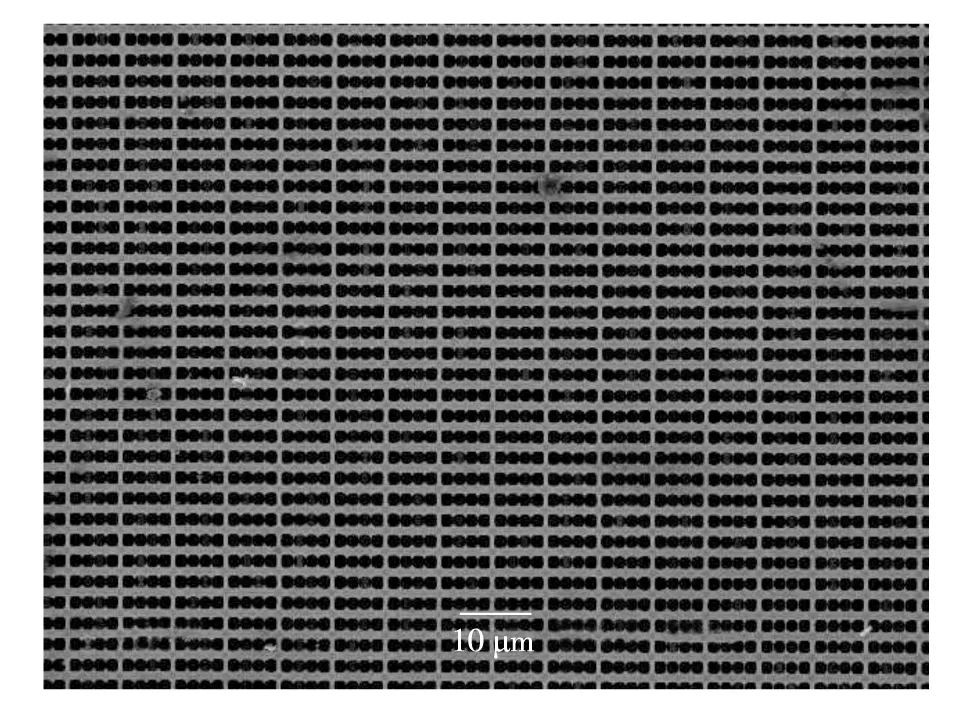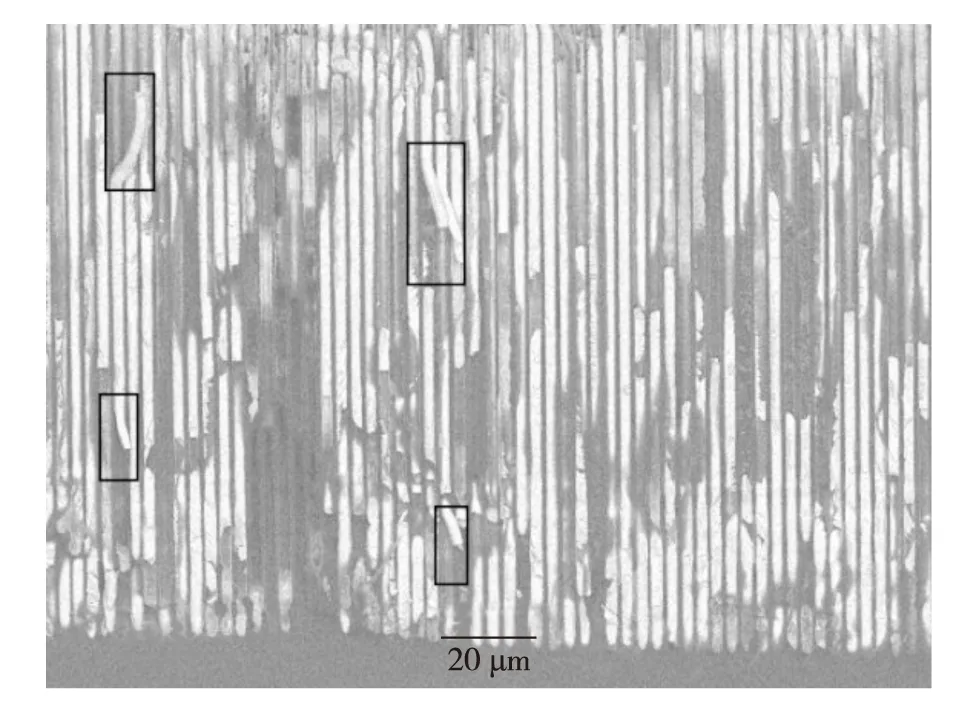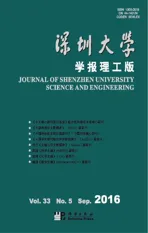Improvement of visibility of moiré fringe in X-ray differential phase-contrast imaging
2016-10-21雷耀虎黄建衡郭金川
雷耀虎,黄建衡,刘 鑫,李 冀,郭金川,
深圳大学光电工程学院,光电子器件与系统教育部/广东省重点实验室,广东深圳 518060
【Optoelectronic Engineering / 光电工程】

Improvement of visibility of moiré fringe in X-ray differential phase-contrast imaging
To fabricate high performance Bi absorption gratings for use in X-ray differential phase-contrast imaging (DPCI), the micro-casting method was improved via surface modification. Bi2O3was used in place of SiO2as an improved wetting layer. A scanning electron microscopy showed that a high filling-ratio analyzer grating with a period of 3 μm and a depth of 150 μm was obtained. Furthermore, the superiority of the presented analyzer grating to the one fabricated using the traditional micro-casting method was revealed through a comparison of moiré patterns. These tests demonstrate an enhancement to the micro-casting method for the fabrication of absorption gratings.
optical engineering; X-ray; phase contrast; absorption grating; micro-casting; moiré fringe; bismuth
X射线微分相衬成像系统莫尔条纹对比度的改善
深圳大学光电工程学院,光电子器件与系统教育部/广东省重点实验室,广东深圳 518060
Since Pfeiffer et al.[1]proposed the use of an X-ray tube in X-ray differential phase-contrast imaging (DPCI), the technology has garnered more attention than other X-ray phase-contrast methods. As a result, DPCI is expected to find applications in product inspection, medical imaging, and other non-destructive observation systems[2-5].
The quality of a phase-contrast image depends strongly on the visibility of the moiré fringe[6-7]. The main factor influencing the fringe visibility is the transmission of X-ray through the absorption grating metal[8]. For the device presented in this work, the transmission is determined primarily by the height of Bi in the absorption grating[9]. This paper reports an improvement to the micro-casting process, which is used to fabricate an analyzer grating with a higher Bi filling-ratio to enhance moiré fringe visibility. Differing from LIGA (lithography, electroplating and molding) and David’s process[10-13], the micro-casting method has proven to be a low-cost way to fabricate Bi absorption gratings[14]. The fabrication process as previously described involves the formation of high aspect-ratio (HAR) grating structures, surface modification, and the filling of these structures with molten Bi[15]. However, in previous efforts, the molten Bi did not fully fill these structures (period of 3 μm and depth of 150 μm), especially close to the bottom. It was concluded that insufficient wettability between the layer of the SiO2and the molten Bi might have been the issue. To address this issue, Bi(NO3)3in acetone was used to fill the grating structures and to cover the side walls under vacuum pressure and ultrasonic treatment. Bi(NO3)3then decomposed to Bi2O3before the molten Bi filling to avoid the agglomerate of unwanted Bi on the upper surface of the analyzer grating. Furthermore, to quantify the improved performance of the presented analyzer grating in comparison to the previously produced one, a comparison between their moiré fringes is given.
1 Experiment

Fig.1 Scanning electron microscope(SEM) image of the upper surface of the analyzer grating图1 分析光栅结构上表面的电镜照片
For the first step of micro-casting, the analyzer grating structure was fabricated using photo-assisted electrochemical etching (PAEE)[16-17]. A structure was obtained with a period of 3 μm and a depth of 150 μm in a 5-inch n-type <100> silicon wafer. This process has been reported previously[15,18]. Note that the side walls of the analyzer grating were reinforced by the vertical walls, giving the analyzer grating the appearance of a pore array, as shown in Fig.1.
In the second step, a wetting layer was established on the surfaces, including the side walls. The improved surface modification can be divided into two stages: filling with low and high concentration solutions; and the transformation from Bi(NO3)3to Bi2O3. First, Bi(NO3)3was dissolved in highly volatile acetone to form low (4%) and high (29%) concentration solutions. Experiments revealed that different concentration Bi(NO3)3solutions showed different physical characteristics on the structure surfaces. A lower concentration solution results in a smaller contact angle, which is beneficial to overcoming surface tension. Therefore, after the structure was filled with the low concentration solution, a thin Bi(NO3)3layer was deposited on the surface of side walls. A higher concentration solution results in a larger contact angle, which can make it difficult (or impossible) to enable complete filling. However, a small contact angle would appear if the high concentration solution contacts with the thin layer formed by the low concentration solution. As a result, more Bi(NO3)3was introduced. Therefore, successive application of the low and the high concentration solutions in a vacuum environment ensured full application of the Bi(NO3)3along all surfaces. It should be noted that the solution flowed freely into the structures if sonicated at a frequency of 80 kHz. The Bi(NO3)3collects unwanted Bi agglomerates on the upper surface of the analyzer grating after the third step, but the Bi2O3leads to a clean surface. Therefore, for the second stage, after the solvent was completely dispersed, the structure was heated to 600 ℃ to transform the Bi(NO3)3·5H2O in the structure to a Bi2O3powder.
For the third step, the analyzer grating structure was filled with molten Bi by use of a high temperature and pressure furnace, which has been described previously[15]. The structure was immersed into the container, which is full of molten Bi. Due to the wetting layer and the applied pressure (0.7 MPa), the molten Bi flowed freely into the HAR structure until it reached the bottom. Then, the structure was removed from the container and allowed to cool to room temperature.
2 Results and test
A SEM cross-section back-scattered image of the analyzer grating is shown in Fig.2. The bright lines correspond to the filled Bi. It should be noted that during the preparation of the sample, breakage can occur in a filled Bi line, as shown in the black outlines in Fig.2. The interruptions of some Bi lines result in the observation of some dark regions. The result shows that the molten Bi reached the bottom of the grating structure. Compared to existing results[14], the advantage of the improved micro-casting method is clear. Additionally, a source grating was also fabricated using the improved micro-casting method, and the SEM cross-section image is shown in Fig.3. The black and the grey regions correspond to the silicon and the filled Bi, respectively.

Fig.2 SEM cross-section back-scattered image of the analyzer grating图2 分析光栅侧视电镜背散射照片
To evaluate performance, an X-ray DPCI system was constructed to observe the improvement of the analyzer gratings from the contrast of moiré fringes. Two absorption gratings (a source grating with period of 42 μm and depth of 150 μm and an analyzer grating) and a phase grating (period of 5.6 μm and depth of 41 μm) were used, as shown in Fig.4. The distance between the source grating and the phase grating was 1 470 cm, and the distance between the phase grating and the analyzer grating was 10.5 cm. The conventional tungsten target X-ray tube was run at 60 kV/ 2 mA. A CsI(Tl) scintillator is coupled to a cooled CCD camera (ANDOR 2 048×2 048, 13.5 μm/pixel) through a fiber tape with a magnification of 0.5 as the image detector. Through adjustment of the angle between the phase grating and the analyzer grating, the moiré fringes were registered by the detector, as shown in Fig.5(a). The moiré fringe pattern shown in Fig.5(b) corresponds to the analyzer grating fabricated using the previous micro-casting method. The normalized intensities along the lines in Fig.5(a) and Fig.5(b) are shown in Fig.5(c) and Fig.5(d). From this measurement, the improvement percentage of the fringe visibility was determined to be 31.6 %.

Fig.4 Schematic diagram of the constructed DPCI system and the moiré fringe registered by the X-ray detector图4 X射线微分相衬成像系统与莫尔条纹示意图

Fig.5 Moiré fringes obtained using the DPCI system and the normalized intensities along the lines图5 实验获取的X射线微分相衬成像系统莫尔条纹及其对应的归一化强度曲线
Conclusions
An improved micro-casting method for the fabrication of absorption gratings was developed. The micro-casting process was improved through surface modification. By covering the grating structure with a layer of Bi2O3, the molten Bi could flow freely into the HAR microstructures, resulting in a higher filling ratio. The comparison of the visibility of moiré fringes in DPCI demonstrates that the improved micro-casting method can provide the Bi analyzer gratings with enhanced performances.
Acknowledgments:We thank Mrs. Xu Guiwen in College of Optoelectronic Engineering, Shenzhen University, for her help of the SEM images.
/
[1] Pfeiffer F, Weitkamp T, Bunk O, et al. Phase retrieval and differential phase-contrast imaging with low-brilliance X-ray sources[J]. Nature Physics, 2006, 2(4): 258-261.
[2] Momose A, Kuwabara H, Yashiro W. X-ray phase imaging using Lau effect[J]. Applied Physics Express, 2011, 4(6): 066603.
[3] Donath T, Pfeiffer F, Bunk O, et al. Phase-contrast imaging and tomography at 60 keV using a conventional X-ray tube source[J]. Review of Scientific Instruments, 2009, 80(5): 053701.
[4] Bech M, Jensen T H, Feidenhans’l R, et al. Soft-tissue phase-contrast tomography with an X-tube source[J]. Physics in Medicine and Biology, 2009, 54(9): 2747-2753.
[5] Pfeiffer F, Bech M, Bunk O, et al. Hard-X-ray dark-field imaging using a grating interferometer[J]. Nature Materials, 2008, 7(2): 134-137.
[6] Yashiro W, Takeda Y, Momose A. Efficiency of capturing a phase image using cone-beam X-ray Talbot interferometry[J]. Journal of the Optical Society of America A, 2008, 25(8): 2025-2039.
[7] Revol V, Kottler C, Kaufmann R, et al. Noise analysis of grating-based X-ray differential phase contrast imaging[J]. Review of Scientific Instruments, 2010, 81(7): 073709.
[8] Huang Jianheng, Du Yang, Lei Yaohu, et al. Noise analysis of hard X-ray differential phase contrast imaging[J]. Acta Physica Sinica, 2014, 63(16): 168702.(in Chinese)
黄建衡,杜杨,雷耀虎,等.硬X射线微分相衬成像的噪声特性分析[J].物理学报,2014, 63(16): 168702.
[9] Huang Jianheng, Lei Yaohu, Du Yang, et al. Quantitative analysis of fringe visibility in grating-based X-ray phase-contrast imaging[J]. Journal of the Optical Society of America A, 2016, 33(1): 69-73.
[10] Kenntner J, Grund T, Matthis B, et al. Front and backside structuring of grating for phase contrast imaging with X-ray tubes[C]// International Conference on Developments in X-ray Tomography. San Diego, USA: SPIE, 2010: 780408.
[11] Noda D, Tanaka M, Shimada K, et al. Fabrication of large area diffraction grating using LIGA process[J]. Microsystem Technologies, 2008, 14(9/10/11): 1311-1315.
[12] Noda D, Tsujii H, Takahashi N, et al. Fabrication of high precision X-ray mask for X-ray grating of X-ray Talbot interferometer[J]. Microsystem Technologies, 2010, 16(8): 1309-1313.
[13] David C, Bruder J, Rohbeck T, et al. Fabrication of diffraction gratings for hard X-ray phase contrast imaging[J]. Microelectronic Engineering, 2007, 84(5/6/7/8): 1172-1177.
[14] Lei Yaohu, Du Yang, Li Ji, et al. Application of Bi absorption gratings in grating-based X-ray phase contrast imaging[J]. Applied Physics Express, 2013, 6(11): 117301.
[15] Lei Yaohu, Du Yang, Li Ji, et al. Fabrication of X-ray absorption gratings via micro-casting for grating-based phase contrast imaging[J]. Journal of Micromechanics and Microengineering, 2014, 24(1): 015007.
[16] Lehmann V, Föll H. Formation mechanism and properties of electrochemically etched trenches in n-type silicon[J]. Journal of The Electrochemical Society, 1990, 137(2): 653-659.
[17] Lehmann V. The physics of macropore formation in low doped n-type silicon[J]. Journal of the Electrochemical Society, 1993, 140(10): 2836-2843.
[18] Lei Yaohu, Liu Xin, Guo Jinchuan, et al. Development of X-ray scintillator functioning also as an analyser grating used in grating-based X-ray differential phase contrast imaging[J]. Chinese Physics B, 2011, 20(4): 042901.
【中文责编:方圆;英文责编:木南】
Lei Yaohu,Huang Jianheng, Liu Xin,et al.Improvement of visibility of moiré fringe in X-ray differential phase-contrast imaging[J]. Journal of Shenzhen University Science and Engineering, 2016, 33(5): 506-510.

College of Optoelectronic Engineering, Key Laboratory of Optoelectronic Devices and Systems of Ministry of Education and Guangdong Province, Shenzhen University, Shenzhen 518060, Guangdong Province, P.R.China
为制作高质量的铋吸收光栅以提高X射线微分相衬成像系统性能,针对表面改性环节对微铸造技术进行改进,以Bi2O3取代SiO2作为改进的浸润层.在周期为3 μm、深度为150 μm的分析光栅结构上制作了具有高填充率的分析光栅,获得了该光栅的扫描电子显微镜照片.为进一步表明改进微铸造技术制作分析光栅的优越性,与改进前的分析光栅进行对比.将两种光栅先后置于X射线微分干涉相衬成像系统中,分别获取了系统莫尔条纹.从最终的条纹对比度上判断,改进后的微铸造技术制作的分析光栅填充率明显提高.
光学工程;X射线;相衬;吸收光栅;微铸造;莫尔条纹;铋
国家重大科研仪器设备研制专项基金资助项目(61227802);国家自然科学基金资助项目(61405120)
雷耀虎(1984—),男,深圳大学讲师、博士.研究方向:X射线相衬成像、微纳制作.E-mail: yfyt10@163.com
2016-03-07;Accepted:2016-04-05
O 434.19; O 647.5Document code: Adoi:10.3724/SP.J.1249.2016.05506
Foundation:National Special Foundation of China for Major Science Instrument (61227802); National Natural Science Foundation of China (61405120)
† Corresponding author:Associate professor Li Ji.E-mail: liji@szu.edu.cn
引文:雷耀虎,黄建衡,刘鑫,等.X射线微分相衬成像系统莫尔条纹对比度的改善[J]. 深圳大学学报理工版,2016,33(5):506-510.(英文版)
